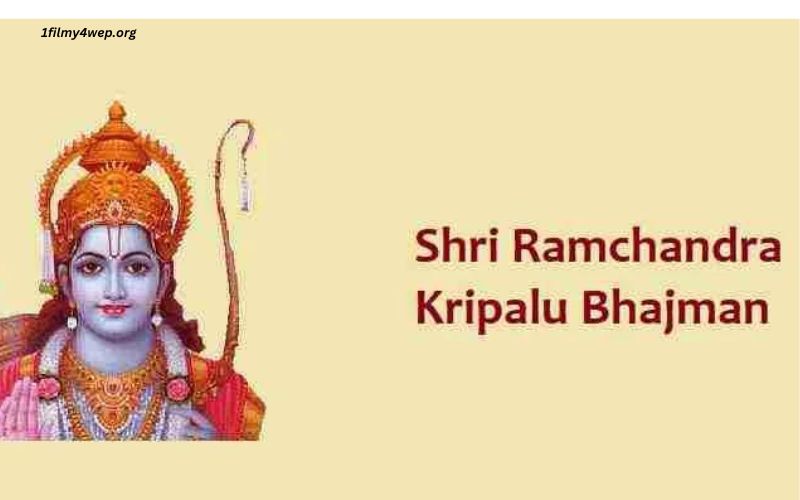Historical Background
The hymn “Shri Ram Chandra Kripalu Bhajman” is attributed to Goswami Tulsidas, a 16th-century Hindu poet-saint, revered for his devotion to Lord Rama. Tulsidas is also known for his magnum opus, the “Ramcharitmanas,” a retelling of the Sanskrit epic Ramayana in the Awadhi language. His works have had a profound influence on the Bhakti movement, promoting devotion to a personal god and the universal truths of dharma (righteousness).
Lyrics and Meaning
The lyrics of “Shri Ram Chandra Kripalu Bhajman” are written in a poetic style that captures the essence of devotion. Below are the lyrics in Hindi, followed by an exploration of their meaning:
Shri Ram Chandra Kripalu Bhajman Lyrics in Hindi
Analysis of the Lyrics
The hymn begins with a call to the mind to worship Lord Rama, the compassionate one, who destroys the severe fear of worldly existence. Each verse praises different aspects of Lord Rama’s persona and his divine beauty, while also acknowledging his heroic deeds and his role as a protector and savior.
- Verse 1:“Oh mind, worship the compassionate Lord Rama, who dispels the terrible fear of the cycle of birth and death. His eyes are like fresh lotuses, his face is like a lotus, his hands are like lotuses, and his feet are like red lotuses.”This verse emphasizes the beauty and grace of Lord Rama, likening his features to lotuses, a symbol of purity and divine beauty in Hindu iconography.
- Verse 2:“His beauty surpasses that of countless Cupids, and his complexion is like a fresh blue cloud. He wears yellow garments that shine like lightning, and I bow to him, the beloved of Sita, the daughter of Janaka.”This verse highlights the incomparable beauty of Lord Rama and his divine form, further emphasizing his purity and radiance.
- Verse 3:“Worship the friend of the downtrodden, the sun among the gods, the destroyer of the demon race. He is the joy of the Raghu dynasty, the source of bliss, and the son of Kaushalya and Dasharatha.”This verse praises Lord Rama’s role as a protector and savior, highlighting his compassion and strength in vanquishing evil.
- Verse 4:“He is adorned with a crown, earrings, and a beautiful tilak. His generous form is embellished with ornaments. He carries a bow and arrows, and he has conquered the demons Khara and Dushana in battle.”This verse portrays Lord Rama as a regal and heroic figure, adorned with royal ornaments and equipped for battle, underscoring his role as a warrior and protector.
- Verse 5:“Thus speaks Tulsidas, delighting the minds of sages like Shankar and Shesha. O Rama, make my heart your abode and destroy the wicked desires and vices within me.”The final verse is a personal plea from Tulsidas, seeking Lord Rama’s grace to reside in his heart and cleanse him of his inner impurities.
Spiritual Significance
The hymn “Shri Ram Chandra Kripalu Bhajman” is not just a song of praise but a profound spiritual invocation. Each verse is a step towards deeper devotion and a reminder of the divine qualities of Lord Rama. The hymn serves multiple purposes in the spiritual practice of devotees:
- Devotional Practice: Reciting or singing this hymn fosters a sense of connection with Lord Rama, enhancing the devotee’s bhakti (devotion) and love for the deity.
- Meditative Focus: The lyrical beauty and repetitive nature of the hymn help in focusing the mind during meditation, bringing a sense of peace and tranquility.
- Moral Guidance: The verses highlight the virtues of Lord Rama, serving as moral exemplars for devotees to emulate in their lives.
- Spiritual Cleansing: By invoking the grace of Lord Rama, devotees seek to cleanse their hearts of negative tendencies and cultivate positive qualities like compassion, courage, and righteousness.
Cultural Impact
“Shri Ram Chandra Kripalu Bhajman” has had a significant impact on Hindu culture and religious practices. It is commonly sung during Ram Navami, the festival celebrating the birth of Lord Rama, as well as during other religious ceremonies and daily worship. The hymn’s popularity extends beyond India, reaching Hindu communities around the world.
The hymn’s influence is also evident in various art forms, including classical music and dance. It is often performed in concerts, temple rituals, and during classical dance recitals, further embedding it in the cultural fabric.
Conclusion
“Shri Ram Chandra Kripalu Bhajman” is a timeless hymn that continues to inspire and uplift devotees. Its lyrical beauty, profound meaning, and spiritual significance make it a cherished part of Hindu devotional literature. Through the praise of Lord Rama’s divine qualities and heroic deeds, the hymn offers a pathway to deeper devotion and spiritual growth. Whether recited in solitude or sung in a communal setting, this hymn remains a powerful expression of faith and a source of divine inspiration for millions.

